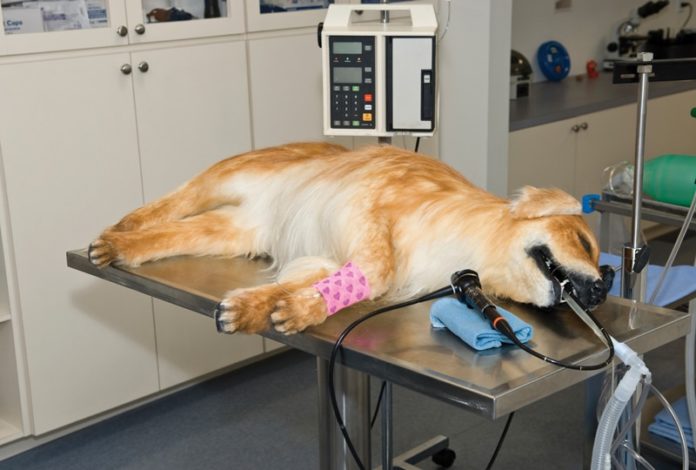Anesthesia
- Defined as total but reversible loss of sensation in a particular part of the body (local anesthesia) or entire body (general anesthesia) which results from administration of a drug that depress the activity of part or all the nervous system.
- 2 types- General Anesthesia & Local Anesthesia
General Anesthesia
- Inhalant
- Injectable-
- Barbiturates
- Non-Barbiturates
- Dissociative
Injectable anesthetic
- Dissociative anesthesia: Dissociative anesthesia is a drug which reduces (or blocks) signals to the conscious mind from other parts of the brain, typically, limited to the senses. Such a state of sensory deprivation and dissociation, hallucinations and dream like states of mind.
1. Ketamine
2. Phencyclidine
3. Tiletamine
4. Telazol :Tiletamine+ Zolazepam
KETAMINE
- It is a dissociative anesthetic for use in human and veterinary medicine developed by Parke-Davis (1962).
- Cattle : 2 to 5 mg/kg B.W IM
- Sheep/Goat : 5-10 mg/kg B.W IM
- Cat : 44 mg/kg B.W IM
- Side Effects:
- Severely impairs all senses, especially:
- Sight
- Balance
- Sense of time
TILETAMINE
- Tiletamine is a dissociative anaesthetic and pharmacologically classified as an NMDA receptor antagonist
- It is used in veterinary medicine in combination with zolazepam, 50mg/ml of each in 5ml vial (Telazol) as an injectable anesthetic.
- Contraindicated in animals with
- CNS signs
- Hyperthyroidism
- Cardiac diseases
- Pancreatic or renal diseases
- Pregnancy
- Glaucoma
- Penetrating eye injuries
PENTOBARBITAL
- It is mostly used of dogs & cats @ 30 mg/kg b. wt. IV
- Now-a-days it is not used to produce anaesthesia in cattle & horse because of prolonged recovery period and marked respiratory depression.
- It should not be administered to the animals less than 1 month of age.
- At the time of recovery animal exhibited shivering, crying, involuntary running, increased respiration and severe staggering.
- Recovery may occur in 6-18 hrs.
- It freely crosses placental barrier and contraindicated for caesarian section.
- It is similar to thiopentone except not containing suphur
- It is 3 times more potent than thiopentone.
- Its short duration of action is due to more redistribution than rapid metabolism.
- It is used in 2.5% solution and solution is stable for 6 weeks at room temperature.
- It produces quick recovery than thiopentone which may accompanied by muscular tremors & violent excitement
- Dose
- Dog and cat @ 6-10 mg/ kg b. wt. IV
- Horses @ 1 gm/175 kg b. wt. IV
- Cattle @ 2.5 – 4.0 mg/kg b. wt. IV
THIOBARBITURATES
(THIOPENTAL SODIUM)
- It is a thio analogue of pentobarbital sodium.
- It is unstable in aqueous solutions at room temperature.
- As the solution aged it loose its potency through the toxicity did not increased.
- Initially it produces marked depression of respiratory centers and brief period of apnea.
- It produces unconsciousness in 15-20 sec and consciousness regained in 10-20 min.
- It is poor analgesic thus painful procedures should be done under the influence of analgesics as Xylazine, opioids and N2O.
- It is a weak muscle relaxant.
- Respiration & B.P. falls immediately after induction.
- For small animals 1.25%, 2.5% and 5% solutions are used
- 2.5% solution is safer than 5% because chances of overdosing reduced and margin of safety become wide.
- On perivascular administration, it causes irritation and sloughing of the area known as barbiturate slough.
- It is contraindicated in neonates.
- Repeated doses have cumulative effects.
- Dose
- Dogs & cats @10-30 mg/kg IV (without preanaesthetics) @ 8-15 mg/kg IV (with preanaesthetics)
ALTHESIN
- It is a combination of two steroids alphaxalone and alphadolon acetate.
- It contains alphaxalone 9 mg/ml and alphadolone acetate 3 mg/ml dissolved by 20% w/v polyoxyethylated caster oil as vehicle.
- In cats a dose of 9 mg/kg is used for IV anaesthesia and 12-18 mg/kg for IM anaesthesia.
- It does not produce pain on perivascular or IM injection.
- The recovery is rapid.
- Althesin produce good muscle relaxation.
- Side Effect:
- Urination
- Defecation
- muscle tremors,
- paddling
- Salivation
- Edema of feet, ear or muzzle may occur in 25% cats which disappear within 2 hrs.
- In dogs – allergic reaction & urticaria formation
- It does not produce malignant hyperthermia in pigs and can be used safely in this species.
CHLORAL HYDRATE
- It is colourless translucent crystals that volatilize on exposure to air with penetrating odour.
- 1 gm dissolves in 0.25 ml of water.
- It may be administered orally or solutions may be injected IV or intra peritoneally.
- It irritates the gastric mucosa and causes vomiting if not diluted in water.
- It is rapidly absorbed from GIT.
- It depresses the cerebrum.
- It is a good hypnotic, basal narcotic but poor anaesthetic
- In anesthetic doses it has narrow margin of safety
- It is a weak analgesic.
- Anaesthetic doses of chloral hydrate depress the vasomotor centers severely results into fall of B.P.
- Respiratory centers are also depressed severely.
- Death may occur due to respiratory arrest.
- It is mostly used for large animal anaesthesia and can be combined with barbiturate 7-12% w/v aqueous solutions.
- Dose in horses is 2-3 gm/45 kg as sedative and 10g/45 kg as anesthetic.
EQUITHESIN
Chloral Hydrate, Mag. Sulph. & Pentobarbital Na
- Composition:
- Chloral hydrate 28 gm
- Magnesium sulphate 14 gm
- Pentobarbital sodium 6.5 gm
- Distt. water to make 1000 ml
- Advantages:
- No excitement during induction
- Complete immobility during short period of anesthesia (15-30 min)
- Wide margin of safely
- Economically
PROPOFOL
- It is 2, 6-di isopropyl phenol
- It is slightly soluble in water and marketed as an aqueous emulsion containing 10 mg of propofol, 100 mg of soybean oil, 22.5 mg of glycerol and 12 mg of egg lecithin per ml.
- It has rapid onset of action (15-45 sec) is due to the rapid uptake in CNS.
- The short duration of action 10-15 min is due to rapid redistribution from brain to the other tissue and efficient elimination from plasma by metabolism.
DIFFERENT ANAESTHETIC COMBINATIONS
- HORSE
- A freshly prepared solution containing chloral hydrate (28 gram) + magnesium sulphate (14 gram) +Pentobarbital sodium (100 gram) + distill water (1000 cc) is stated the best intravenous anesthetic.
- BOVINE
- Bovine is not a good subject for G.A.
- Probably the safest is to use I/V a combination of chloral hydrate (12%) + magnesium sulphate (6%)
- PORCINE
- Chloral hydrous (12%) + magnesium sulphate (6%) solution, I/V approx. dosage required is equivalent to 2 grains at chloral hydrous per lb body weight.
- Pentobarbital sodium I/V serves as a very good general anaesthesia
- OVINE
- Pentobarbital sodium may be used for basal narcosis and chloral hydrous is administered I/V as a 7% solution.
Inhalant anesthetics
- Depend on physical characteristics, there are two classes:
- Volatile liquid: Supplied in bottles, low boiling point, evaporation makes vapour.
e.g. ether, chloroform, isoflurane etc.
- Gaseous: Supplied in cylinders.
e.g. N2O (Blue cylinder)
Cyclopropane (Orange cylinder)
HALOTHANE
- It is a colorless, volatile liquid with a non irritant sweet odour.
- Some decomposition takes place when exposed to light.
- It is non explosive and non inflammable, expensive volatile anaesthetic agent.
- It has quick and pleasant induction.
- At the conc. of 2-4% it produces medium to deep anaesthesia within 2-5 min.
- Anaesthesia is maintained at the rate of 0.8 – 1.2 %.
- Halothane is about twice as potent as chloroform and 4 times as ether.
- It is not a good analgesic or muscle relaxant.
- It produces rapid and smooth recovery.
- It also produces hypotension and bradycardia.
- Respiratory rate is decreased.
- Salivary, mucus and bronchial secretions are absent.
- It does not cause hepatic toxicity.
- Intestinal and uterine contractions are decreased and urine formation is reduced.
- It eliminates from the body very rapidly thus depth of anaesthesia can be attained very quickly.
- Dose –
- Small animals- induction:3% & maintenance: 0.5-1.5%
- Large animals- MAC value: 1%
ISOFLURANE
- It is an isomer of enflurane.
- It has similar properties but about 1½ times more potent, more volatile and less soluble in blood.
- It produces rapid induction and recovery.
- Respiratory depression is prominent and assisted respiration is essential.
- Secretions are increased slightly.
- Pupils do not dilate even at deeper planes.
- It is slightly irritant and has low toxicity.
- It does not provoke seizures and thus preferred for neurosurgery.
- Dose –
- Small animals- induction:5% & maintenance: 1.5-2.5%
- Large animals- MAC value: 1.5-2.5%
SEVOFLURANE
- It is polyfluorinated anaesthetic with properties intermediate between Isoflurane and Desflurane.
- It is ten times more potent than desfluranes.
- Induction and recovery is fast and rapid changes in depth are achieved.
- It has pleasant odour and recovery is smooth.
- It does not cause airway irritation even during rapid induction.
- B.P. and respiratory rate are decreased.
- It is not recommended for use in closed circuit because it is degraded by soda limes.
NITROUS OXIDE
- It is colorless, odorless and heavier than air and non inflammable gas, supplied under pressure in cylinders.
- It is non irritant.
- Nitrous oxide-oxygen mixture (4:1) are administered for deep anaesthesia in horse.
- Unconsciousness can not be produced in any patient.
- N2O is a good analgesic but poor muscle relaxant.
- Onset is quick and smooth, while recovery is rapid.
- It is generally used as a carrier and adjunct to other anaesthetics.
- It is non toxic to liver, kidney and brain.
Local Anesthetics
BUPIVACAINE
- Onset and depth of anaesthesia is same as lignocaine but it has longer duration of anesthesia (4-6 hrs).
- It is approximately 4 times more potent as lignocaine.
- It is a stable compound & have wide margin of safety.
- 0.25% is used for infiltration anaesthesia & 0.5% for conduction anaesthesia or nerve blocks.
- Concentrations more than 0.5% are irritant to tissues.
- It produce corneal anaesthesia.
- It can be used for urethral catheterization itching, bronchoscopy, esophagoscopy and tonometry .
LIDOCAINE/ LIGNOCAINE
- This compound was introduced in the year 1944 and is very effective local anaesthetic and replaced procaine and other L.A.
- It is also known as lignocaine, xylocaine, vessicaine and gesicaine.
- It is stable when boiled with strong alkali or acid.
- It may be autoclaved repeatedly.
Author Bio : Anjaria Pranav Ashok

















